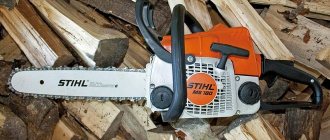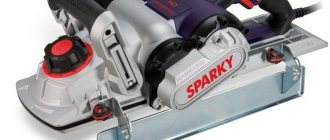How to choose a tire for a chainsaw - tips and tricks
When purchasing a new tire for your chainsaw, it is important to initially pay attention to the material from which the part is made, as well as the quality of the product and the presence of markings. The absence of markings indicates that the headset was manufactured underground, and it is not recommended to purchase such a part. When purchasing a guide for a chainsaw, you should also pay attention to three main parameters:
- Tail part - this part of the part may differ for different models of chainsaws, so make sure in advance that the part is suitable for your tool. The shank of the guide must match the shape of the chainsaw seat. If you install a guide that does not match the shape of the seat, then oil will not be supplied to the chain, which will lead to accelerated wear of the headset
- Groove width - depends on the type of chainsaw accessory and its power
- Driven sprocket - it is better to buy guides that are equipped with all-metal sprocket options, especially if you plan to saw hard trees
- The pitch of the guide and chain must be the same as the drive sprocket. If the pitch is different, this will lead to unstable operation of the engine and rapid wear of the headset. If the sprocket pitch is 0.325, then the chain and guide should have a similar value
When purchasing, also take into account the recommendations presented in the material, that is, tire type, length, groove size.
Thickness of link components (tails)
The main part of the load falls on this element of the chainsaw. To measure the thickness of the connecting elements of the chain included in the tire, use a caliper.
Let's list the standard indicators:
- 1.1-1.3 mm - more often found in products for infrequent home use and gentle operation. This tail thickness is suitable for light loads.
- 1.5mm is the most common option found in household saws, but is not suitable for heavy-duty applications.
- 1.6-2.0 mm is an option for complex work. This width of tails is found in professional saws, the elements of which are made of special steel.
How to install a bar and chain on a chainsaw and adjust the tension
Removing and replacing a tire on a chainsaw is not difficult even for a novice sawyer. Replacement instructions are as follows:
- Using the special wrench that comes with the tool, unscrew the two fastening nuts
- After this, the protective casing, which also serves as a hand brake, is dismantled.
- Removing the chain from the tool
- The part is removed
A new tire is installed in place of the removed guide, after which assembly is performed in the reverse order of removal. At the final stage, it is necessary to adjust the chain tension. To check the degree of tension, pull the chain in the middle of the guide. Correct adjustment is when the output of the shank does not exceed 2/3 of its height. You can make sure that the chain is not overtightened by moving it along the bar, applying a little force.
This is interesting!
To increase or decrease the chain tension, you need to loosen the two fastening nuts and rotate the tension adjusting screw.
On all models of chainsaws it is located in different places. After adjustment, you need to tighten the fastening nuts. Upon completion of the work done, all that remains is to start the engine of the tool and check its operation. The chain should not make a ringing sound, which indicates its correct functioning.
Types of units involved in the work
Chain cutting elements are divided into two types: chisel and chipper. Chisel links are similar in shape to the number 7. These links provide fast and high-quality work.
However, they also have negative sides: firstly, the links are sensitive to dust, dirt and other small debris, secondly, they are not so easy to sharpen, and thirdly, working with such a saw requires great precision.
When you press the gas, the chainsaw starts to stall - causes and solutions to the problemWood splitters - how to choose a good wood splitter for home use, see the article. Lots of photos, reviews, prices, where to buy + new items for 2020
Secateurs - review and tips for choosing the best tools. Rating 2021, prices, secrets, tricks, reviews, recommendations, prices, where to buy
Chipper teeth are shaped like a sickle or a question mark. In contrast to the previous type, their cutting characteristics are not as outstanding, but they are easy to sharpen and are not sensitive to dirt.
Review of the best manufacturers
The domestic market offers a large number of chains for gas and electric saws from Russian, Chinese and other popular foreign manufacturers. The best companies that produce saw accessories for gasoline saws are:
- Oregon. A popular and also one of the most recognized by domestic customers brand, under which high-quality chains for gas and electric saws are produced. In the manufacture of products, a special alloy is used, which is durable and strong. Equipment produced under this brand, as a rule, has a special chrome coating, which significantly increases its service life.
- Stihl. A world-famous German company that produces construction equipment and tools. The company's product list also includes chainsaws, tires and chains. The brand's products have a good margin of safety and reliability.
- Husqvarna. It is not one of the world leaders engaged in the production of chains, but it supplies high-quality saw sets to the domestic market.
- Bison Popular Russian manufacturer of reliable and budget models of chains for garden equipment. The manufacturer's products have increased strength. As a rule, they are more suitable for use in household or semi-professional devices.
Sequence of links
- Standard - 2 driving links + 1 cutting link;
- With semi-pass - 2 links + 1 connecting;
- With a pass - one additional link is installed between each cutting blade.
Main settings
Saw chains are usually distinguished by:
- cutting direction (longitudinal and transverse);
- dimensions (length and size of the elements of the chain set);
- design features;
- the order of the cutting links.
Cutting wood along the grain causes more resistance than cutting across it. Due to the demand for both types of sawing, two types of saw chains are produced - longitudinal and transverse. They differ in the angle of attack of the incisors. As a result, when cutting longitudinally, the productivity of the saw increases, and when cutting transversely, the “aggressiveness” of the tool is smoothed out. Well, together with the latter, it reduces the level of vibrations and reduces the load on the engine.
If quality requirements are not high, longitudinal cutting can be performed with a chain saw with a cross chain.
Chainsaw tires on the market today have different dimensions. One of the main parameters of the saw chain is the number of links, i.e. chain length. In addition, chain systems have a certain pitch. It is measured by the distance between three links connected in series, divided by two.
When is a chain replacement necessary?
Like any other product, the chain must be replaced with a new one as it wears out. In order to delay chain wear, we recommend regularly changing chains during operation: first use one, next time - the second.
This way you will delay the wear and tear of one material and change both the tire and the sprocket at the same time. This principle will help you maximize the service life of the saw elements.
We have listed the main parameters by which the circuits differ from each other. For a more detailed study of chain elements, we recommend that you familiarize yourself with photos of chainsaw chains on the Internet.
Chainsaw bar length - what they are and what it affects
One of the most important parameters of a chainsaw tire is its size. The longer the guide, the larger the diameter of the logs you can cut with the tool. However, this does not mean that you can install a long guide on a low-power chainsaw and cut thick logs. The length of the tire must have a relationship with the power.
This is interesting!
The technical description for each tool model indicates the optimal tire length that the manufacturer recommends to use.
Installing a smaller or larger part will lead to accelerated wear of the saw set and tool mechanisms. If you cannot find the technical data sheet for the tool, then you can find out the recommended length for a specific tool model in a simple way - measure the old guide. Not many experts know how to measure the length of a chainsaw bar. To find out the length of the guide on a chainsaw, you need to use a tape measure and measure the distance from the end (nose) to the beginning of the cutout. The diagram below shows how to correctly measure the length of a tire.
You can also find out the length by the description, which is usually shown on the side of the headset. However, over time the tool is used, the inscriptions become erased, so this method is appropriate for cases when the information on the tire can be read. By measuring the length, you can purchase the appropriate size saw set for the tool. Why can’t you use a long bar and chain on a low-power saw? There are enough reasons for this, and they can be described in the form of a list:
- Lack of engine power, which will affect sawing speed
- Increased fuel consumption due to increased load
- Rapid wear of the engine and consumables
- Incorrect cycle of oil supply to lubricate the chain, which will lead to overheating of the headset and rapid failure
If you do not want the tool to quickly fail, then you need to use a saw set of the appropriate size. To ensure maximum efficiency and performance of the tool, it is necessary to select the correct bar and chain depending on the power of the tool. The unit of measurement used to indicate length is the inch. Below are the dimensions of chainsaw guides in inches, converted to the metric measurement system:
- 10 inches - 25 cm
- 12 inches - 30 cm
- 14 inches - 35 cm
- 16 inches - 40 cm
- 18 inches - 45 cm
Only after the length of the chainsaw bar has been determined can you begin to select a new part. There are also devices with lengths of 38, 33 cm and others. The length of the part is 45 cm - this is still far from the largest option. Professional high-power units are equipped with devices whose length reaches 75 cm.











